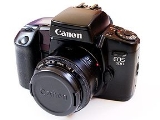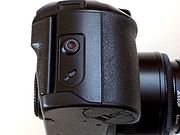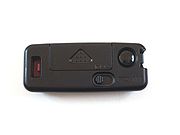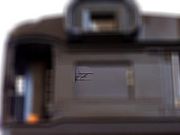
Canon EOS 100
Encyclopedia
The Canon EOS 100 was a 35 mm
autofocus
SLR
camera introduced by Canon in 1991. It was marketed as the EOS Elan in North America. It was the second camera in the EOS
range to be targeted at advanced amateur photographers, replacing the EOS 650
.
Its headline features were near-silent film winding, input of EOS barcode
programs, integral auto-zoom flash, twin input dials, an autofocus auxiliary light for low-contrast subjects and five fully automatic modes.
 The look and feel of the EOS 100 had much in common with the T90
The look and feel of the EOS 100 had much in common with the T90
and EOS 650. It was based around a polycarbonate
body with metal bayonet
lens mount
.
The top left of the body had a Command Dial for choice of either Creative or Image zones and buttons to control the integral flash. The top right of the body had a multi-function Main Dial, buttons for autofocus and film advance control, the shutter release button and an LCD display panel. The back of the body had the Quick Control Dial, used for aperture control, and the AE Lock Button, used to lock exposure settings.
Once the Command Dial had been set for a particular shooting style, all controls could be accessed with the right hand, with the viewfinder
feeding back information to the photographer.

The EOS 100 came with a motorised belt drive for film winding and rewinding. Canon claimed this made it the quietest camera in the EOS range.
The drive also enabled the camera to operate at three frames per second, faster than most of its competitors.
Using the Drive Button, the photographer could choose whether to allow single or multiple photographs to be taken as the shutter release button was held.
The drive could also be disabled to allow up to nine multiple exposure
s to be made.
All powered functions in the EOS 100 came from a single 6 volt lithium
2CR5. There was no option to adapt this to AA
size batteries.
sing (AF) modes: One-shot AF and AI Servo AF.
One-shot AF was used for stationary objects. Once in focus, exposure was calculated then the shutter was released. In low light or low contrast situations, the AF auxiliary light would momentarily project a series of red bands on the subject. This then enabled the AF circuits to have a subject with contrast
they could focus onto.
AI
Servo AF was used for moving objects. The lens would continuously refocus on the object in the centre of the viewfinder whilst the shutter release button was pressed half-way. Once the shutter release button was fully pressed, the exposure was calculated then the shutter released.
Depth of field preview could be enabled via a custom function. If enabled, the aperture would reduce to show the depth of field every time the AE Lock Button was pressed.
s: partial metering (central 6.5% of the picture), centre-weighted average metering and evaluative metering. The current metering mode was displayed on the LCD panel.
The Command Dial gave the photographer the choice of several shooting modes. The operation, and even the symbology used, would eventually be incorporated into Canon's digital camera range. Canon's fully automatic Programmed Image Control modes were Full Auto, Portrait, Landscape, Close-up and Sports.
The manually adjustable shooting modes were Shutter-priority, Aperture-priority and Depth-of-field. In these modes, the exposure could be compensated by ±2 stops in 1/2-stop increments. Also, AEB (auto exposure bracketing
) could be used to take three continuous exposures in sequence, again by ±2 stops in 1/2-stop increments.
All exposure control settings would be ignored when the Command Dial was set to manual. Then, both shutter speed and aperture could be set independently. The viewfinder would still give information on whether the camera thought the shot would be under- or over-exposed, but it wouldn't interfere.
 The EOS 100 had an integrated retractable TTL
The EOS 100 had an integrated retractable TTL
flash. Information via the EF lens mount was used to optimise the zoom setting of the flash. It had three zooms to cover the focal lengths of 28 mm, 50 mm and 80 mm. Consequently, its guide number
for ISO 100 varied between 12 m at 28 mm, to 18 m at 80 mm.
The focal plane shutter gave an X-sync speed of 1/125 second. The flash would normally fire when the first curtain had finished its travel, but this could be changed to the second curtain via a custom function.
Red-eye reduction was achieved by producing a piercing continuous bright light to the left of the flash. This would shine while the flash capacitors were charged.
The flash shoe contained signals for X-sync, red-eye reduction and second curtain sync.

 The only accessory specific to the EOS 100 made by Canon was the GR-70 grip extension. However, unlike other grip extensions, this provide neither further power solutions (e.g. via AA batteries), nor extra shutter release buttons (e.g. for shooting in vertical, portrait orientation).
The only accessory specific to the EOS 100 made by Canon was the GR-70 grip extension. However, unlike other grip extensions, this provide neither further power solutions (e.g. via AA batteries), nor extra shutter release buttons (e.g. for shooting in vertical, portrait orientation).
The EOS 100 had a feature it shared with just one other camera (the EOS 10) in the EOS range; the barcode
reader. With the Command Dial turned to the barcode setting, the camera would accept programming details from Canon's Barcode Reader. Canon published a book of approximately 100 photographs showing different styles of pictures (landscapes, night-time shots, fast moving action, etc). Below each was a barcode which could be scanned by the reader. This reader was then placed against the camera's infrared connection point and the settings were transferred.
The back could not be exchanged, e.g. for date/time stamping. For this functionality, Canon released the EOS 100QD, where QD stood for Quartz Date. Contrary to Canon's own publications, this was marketed worldwide, not just in Japan.
Despite not having many specific accessories, the EOS 100 was built to accept all of Canon's EOS range of accessories:
 The EOS 100 never enjoyed the popularity of the lower-pitched EOS 1000 and it was discontinued in 1995.
The EOS 100 never enjoyed the popularity of the lower-pitched EOS 1000 and it was discontinued in 1995.
As of 2008, EOS 100 bodies can be bought from on-line auction sites from as little as £10/$15.
Along with the T90, and other older Canon SLR film cameras, used EOS 100s can suffer from a 'sticky shutter' problem. This is caused by the camera's internal light sealing foam, which degrades over time and becomes stuck to the shutter, affecting exposures. This can affect the camera's resale value. The command dial is also prone to detachment from the electronic part of the dial, and many used EOS 100s are rendered unusable from this manufacturing flaw.
135 film
The term 135 was introduced by Kodak in 1934 as a designation for cartridge film wide, specifically for still photography. It quickly grew in popularity, surpassing 120 film by the late 1960s to become the most popular photographic film format...
autofocus
Autofocus
An autofocus optical system uses a sensor, a control system and a motor to focus fully automatic or on a manually selected point or area. An electronic rangefinder has a display instead of the motor; the adjustment of the optical system has to be done manually until indication...
SLR
Single-lens reflex camera
A single-lens reflex camera is a camera that typically uses a semi-automatic moving mirror system that permits the photographer to see exactly what will be captured by the film or digital imaging system, as opposed to pre-SLR cameras where the view through the viewfinder could be significantly...
camera introduced by Canon in 1991. It was marketed as the EOS Elan in North America. It was the second camera in the EOS
Canon EOS
The Canon EOS autofocus 35 mm film and digital SLR camera system was introduced in 1987 with the Canon EOS 650 and is still in production as Canon's current DSLR system...
range to be targeted at advanced amateur photographers, replacing the EOS 650
Canon EOS 650
The Canon EOS 650 is a 35 mm single-lens reflex camera. It was introduced on 1 March 1987, Canon's 50th anniversary,and discontinued in February 1989....
.
Its headline features were near-silent film winding, input of EOS barcode
Barcode
A barcode is an optical machine-readable representation of data, which shows data about the object to which it attaches. Originally barcodes represented data by varying the widths and spacings of parallel lines, and may be referred to as linear or 1 dimensional . Later they evolved into rectangles,...
programs, integral auto-zoom flash, twin input dials, an autofocus auxiliary light for low-contrast subjects and five fully automatic modes.
Design

Canon T90
The Canon T90, introduced in 1986, was the top of the line in Canon's T series of 35 mm Single-lens reflex cameras. It was the last professional-level manual-focus camera from Canon, and the last professional camera to use the Canon FD lens mount...
and EOS 650. It was based around a polycarbonate
Polycarbonate
PolycarbonatePhysical PropertiesDensity 1.20–1.22 g/cm3Abbe number 34.0Refractive index 1.584–1.586FlammabilityV0-V2Limiting oxygen index25–27%Water absorption – Equilibrium0.16–0.35%Water absorption – over 24 hours0.1%...
body with metal bayonet
Bayonet mount
A bayonet mount or bayonet connector is a fastening mechanism consisting of a male side with one or more pins, and a female receptor with matching L slots and spring to keep the two parts locked together....
lens mount
Lens mount
A lens mount is an interface — mechanical and often also electrical — between a photographic camera body and a lens. It is confined to cameras where the body allows interchangeable lenses, most usually the single lens reflex type or any movie camera of 16 mm or higher gauge...
.
The top left of the body had a Command Dial for choice of either Creative or Image zones and buttons to control the integral flash. The top right of the body had a multi-function Main Dial, buttons for autofocus and film advance control, the shutter release button and an LCD display panel. The back of the body had the Quick Control Dial, used for aperture control, and the AE Lock Button, used to lock exposure settings.
Once the Command Dial had been set for a particular shooting style, all controls could be accessed with the right hand, with the viewfinder
Viewfinder
In photography, a viewfinder is what the photographer looks through to compose, and in many cases to focus, the picture. Most viewfinders are separate, and suffer parallax, while the single-lens reflex camera lets the viewfinder use the main optical system. Viewfinders are used in many cameras of...
feeding back information to the photographer.
Power features

The EOS 100 came with a motorised belt drive for film winding and rewinding. Canon claimed this made it the quietest camera in the EOS range.
The drive also enabled the camera to operate at three frames per second, faster than most of its competitors.
Using the Drive Button, the photographer could choose whether to allow single or multiple photographs to be taken as the shutter release button was held.
The drive could also be disabled to allow up to nine multiple exposure
Multiple exposure
In photography, a multiple exposure is the superimposition of two or more individual exposures to create a single photograph. The exposure values may or may not be identical to each other.-Overview:...
s to be made.
All powered functions in the EOS 100 came from a single 6 volt lithium
Lithium battery
Lithium batteries are disposable batteries that have lithium metal or lithium compounds as an anode. Depending on the design and chemical compounds used, lithium cells can produce voltages from 1.5 V to about 3.7 V, over twice the voltage of an ordinary zinc–carbon battery or alkaline battery...
2CR5. There was no option to adapt this to AA
AA battery
An AA battery is a standard size of battery. Batteries of this size are the most commonly used type of in portable electronic devices. An AA battery is composed of a single electrochemical cell...
size batteries.
Focusing
The EOS 100 had a single BASIS (BAse Stored Image Sensor) chip, targeting the centre of the viewfinder. This was key to its two autofocusAutofocus
An autofocus optical system uses a sensor, a control system and a motor to focus fully automatic or on a manually selected point or area. An electronic rangefinder has a display instead of the motor; the adjustment of the optical system has to be done manually until indication...
sing (AF) modes: One-shot AF and AI Servo AF.
One-shot AF was used for stationary objects. Once in focus, exposure was calculated then the shutter was released. In low light or low contrast situations, the AF auxiliary light would momentarily project a series of red bands on the subject. This then enabled the AF circuits to have a subject with contrast
Contrast (vision)
Contrast is the difference in visual properties that makes an object distinguishable from other objects and the background. In visual perception of the real world, contrast is determined by the difference in the color and brightness of the object and other objects within the same field of view...
they could focus onto.
AI
Artificial intelligence
Artificial intelligence is the intelligence of machines and the branch of computer science that aims to create it. AI textbooks define the field as "the study and design of intelligent agents" where an intelligent agent is a system that perceives its environment and takes actions that maximize its...
Servo AF was used for moving objects. The lens would continuously refocus on the object in the centre of the viewfinder whilst the shutter release button was pressed half-way. Once the shutter release button was fully pressed, the exposure was calculated then the shutter released.
Depth of field preview could be enabled via a custom function. If enabled, the aperture would reduce to show the depth of field every time the AE Lock Button was pressed.
Exposure control
Light metering consisted of full-aperture through-the-lens metering, using a six zone silicon photocell. Automatic exposure settings were calculated using three metering modeMetering mode
In photography, the metering mode refers to the way in which a camera determines the exposure.- Examples of metering modes :Cameras generally allow the user to select between spot, center-weighted average, or multi-zone metering modes....
s: partial metering (central 6.5% of the picture), centre-weighted average metering and evaluative metering. The current metering mode was displayed on the LCD panel.
The Command Dial gave the photographer the choice of several shooting modes. The operation, and even the symbology used, would eventually be incorporated into Canon's digital camera range. Canon's fully automatic Programmed Image Control modes were Full Auto, Portrait, Landscape, Close-up and Sports.
| Symbol |  |
 |
 |
 |
 |
|---|---|---|---|---|---|
| Description | Full Auto | Portrait | Landscape | Close-up | Sports |
The manually adjustable shooting modes were Shutter-priority, Aperture-priority and Depth-of-field. In these modes, the exposure could be compensated by ±2 stops in 1/2-stop increments. Also, AEB (auto exposure bracketing
Bracketing
In photography, bracketing is the general technique of taking several shots of the same subject using different or the same camera settings. Bracketing is useful and often recommended in situations that make it difficult to obtain a satisfactory image with a single shot, especially when a small...
) could be used to take three continuous exposures in sequence, again by ±2 stops in 1/2-stop increments.
All exposure control settings would be ignored when the Command Dial was set to manual. Then, both shutter speed and aperture could be set independently. The viewfinder would still give information on whether the camera thought the shot would be under- or over-exposed, but it wouldn't interfere.
Flash

Through-the-lens metering
Through-the-lens metering is a photographic term describing a feature of cameras capable of measuring light levels in a scene through their taking lenses, as opposed to a separate metering window...
flash. Information via the EF lens mount was used to optimise the zoom setting of the flash. It had three zooms to cover the focal lengths of 28 mm, 50 mm and 80 mm. Consequently, its guide number
Guide number
The guide number for an electronic flash measures its ability to illuminate the subject to be photographed at a specific film or sensor sensitivity and angle of view...
for ISO 100 varied between 12 m at 28 mm, to 18 m at 80 mm.
The focal plane shutter gave an X-sync speed of 1/125 second. The flash would normally fire when the first curtain had finished its travel, but this could be changed to the second curtain via a custom function.
Red-eye reduction was achieved by producing a piercing continuous bright light to the left of the flash. This would shine while the flash capacitors were charged.
The flash shoe contained signals for X-sync, red-eye reduction and second curtain sync.
Accessories


The EOS 100 had a feature it shared with just one other camera (the EOS 10) in the EOS range; the barcode
Barcode
A barcode is an optical machine-readable representation of data, which shows data about the object to which it attaches. Originally barcodes represented data by varying the widths and spacings of parallel lines, and may be referred to as linear or 1 dimensional . Later they evolved into rectangles,...
reader. With the Command Dial turned to the barcode setting, the camera would accept programming details from Canon's Barcode Reader. Canon published a book of approximately 100 photographs showing different styles of pictures (landscapes, night-time shots, fast moving action, etc). Below each was a barcode which could be scanned by the reader. This reader was then placed against the camera's infrared connection point and the settings were transferred.
The back could not be exchanged, e.g. for date/time stamping. For this functionality, Canon released the EOS 100QD, where QD stood for Quartz Date. Contrary to Canon's own publications, this was marketed worldwide, not just in Japan.
Despite not having many specific accessories, the EOS 100 was built to accept all of Canon's EOS range of accessories:
- all EF lenses
- Speedlite 430EZ flash (guide number 43 m)
- Speedlite 300EZ flash (guide number 28 m)
- ML-3 ring flash
- RC-1 infrared remote control unit
- DioptricDioptric correctionDioptric correction is the expression for the adjustment of the optical instrument to the varying visual acuity of a person's eyes. It is the adjustment of one lens to provide compatible focus when the viewer's eyes have differing visual capabilities...
adjustment lenses for the viewfinder eye piece
Custom functions
The EOS 100 was among the first of Canon's cameras to have the facility to alter its operation via custom functions. These would remain set even if the camera was switched off or the battery replaced.| Custom Function | Description |
|---|---|
| CF1 | 1=Stop film rewind at end of spool. Useful at quiet social events – film is rewound by pressing the film rewind button. |
| CF2 | 1=Second shutter flash sync. Gives more natural speed blurring. |
| CF3 | 1=Ignore DX film coding. Used if the photographer decides to up/down-rate a whole spool. |
| CF4 | 1=Switch off AF auxiliary light. Used if the auxiliary light could distract the subject. |
| CF5 | 1=Enable depth of field preview. Pressing the exposure lock button also sets the aperture so depth-of-field can be seen through the viewfinder. |
| CF6 | 1=Turn all warning bleeps off. Makes the camera even quieter. |
| CF7 | 1=Mirror up at start of countdown timer. Used to minimise all possibility of camera shake. |
Use today

As of 2008, EOS 100 bodies can be bought from on-line auction sites from as little as £10/$15.
Along with the T90, and other older Canon SLR film cameras, used EOS 100s can suffer from a 'sticky shutter' problem. This is caused by the camera's internal light sealing foam, which degrades over time and becomes stuck to the shutter, affecting exposures. This can affect the camera's resale value. The command dial is also prone to detachment from the electronic part of the dial, and many used EOS 100s are rendered unusable from this manufacturing flaw.

